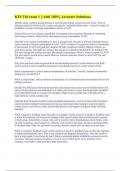KIN 310 exam 1 || with 100% Accurate Solutions.
Identify some common measurements in exercise physiology correct answers work= force X
distance( joule (J)=Newton (N) x meter (m)) power= work divided by time::: watt (w)= joule (J)
divided by second (s) Energy expenditure, calorie or VO2
Explain the two ways energy expenditure is measured correct answers Directly by measuring
heat energy (calorie), Indirectly by measuring oxygen consumption (VO2)
Describe what oxygen consumption is, how it is expressed, and why it increases during exercise.
correct answers Oxygen consumption is VO2: VO2 is volume of oxygen our body is consuming,
at rest around 3.5 ml of oxygen per kilogram of body weight per minute, During exercise, we
need more energy to be able to workout, that energy is sourced by foodstuff or by making ATP.
We need energy for cellular activities like muscle contractions which is sourced mainly by ATP.
We also need to recruit more muscle fibers as exercise increases which we need ATP for and
ultimately oxygen.
Why does our body need oxygen both at rest and during exercise? correct answers Our body
needs oxygen at rest to maintain homeostasis and during exercise to create energy (ATP)
What is homeostasis? correct answers maintenance of constant, "normal" internal environment
during rest, around 98.6 F
What is steady-state? correct answers maintenance of a constant internal environment Not at rest
(during exercise)
Identify the differences between homeostasis and steady-state correct answers Homeostasis will
always be the same for one individual, it is when your body is at rest, but steady state can differ
in an individual based on exercise for example a light exercise steady state will differ from a
high intensity exercise steady state
Describe how biological control systems maintain homeostasis. correct answers Our biological
control systems maintain homeostasis by having mechanisms that include a sensor(receptor),
control center, and effector. More specifically positive and negative feedback loops will help
maintain.
What is negative feedback loop? Describe an example. correct answers A negative feedback loop
is when the response will reverse the change in the control center back to homeostasis. increase
in body temp, detected by a sensor, info sent to control center, hypothalamus in the brain, come
up with a response, send response to effectors, then lowers body temp, increase sweating, dilate,
to dissipate heat, Once we get back to set point, then the sensor will not sense so it just stops
What is a positive feedback loop? correct answers A positive feedback loop is when the response
is enhanced/stimulated more. This is not common and happens during labor. This also needs to
have a stop signal, it won't stop by itself. Labor contraction during childbirth, pressure in cervix
increases, stimulate sensory receptors, oxytocin, moves baby down, more pressure, more
oxytocin, once baby is delivered that stops stimulation
, What does it mean for the body to undergo adaptations follow exercise training? correct answers
Describe the 5 ways of cellular signaling. correct answers Intracrine: messenger within cell
triggers pathway within same cell(Skeletal muscle cell adaptation, strength training, muscle
hypertrophy, bigger muscle)- Justactrine: cells communicate via cell-to-cell contact (Cardiac
cells during contraction)-Autocrine: messenger produces and released by cell acts on same cells
(T-cell proliferation elicited by cytokines)- Paracrine: messenger releases by cell act on nearby
cells (Nitric oxide released by endothelial cells acton vascular smooth muscle cells)- Endocrine:
messenger (hormone) travels in blood to target organ (Glucagon released by pancreas stimulates
the breakdown of glycogen in the liver (glovcogencylic))
Define what metabolism is and the types of reactions involved. correct answers Metabolism is
the total of all cellular reactions in the body, Anabolic: synthesize, consume energy (endergonic),
Catabolic: decompose, release energy (exergonic), Often occur as Coupled reactions
2. Describe what happens during an oxidation-reduction reaction. correct answers You have an
oxidation reaction which is when you are removing an electron, the "reducing agent" and then
reduction reaction is when you gain an electron "oxidizing agent". These are always coupled
because in order to remove an electron you need one available to be put on and take its place.
Oxidation does not mean O2 is involved, but O2 does accept electrons often, o2 could be the
oxidizing agent. Reactions often include the transfer of hydrogen (dehydrogenation, losing
electron and hydrogen)
Identify what NAD+ and FAD are. correct answers
What are enzymes? What factors affect their activity? correct answers Enzymes are protein
molecules that regulate the rate of a reaction, they lower the activation energy(Minimum amount
of energy required to activate the atoms or molecules to a condition where they can undergo a
reaction) making it easier/faster to start and have a reaction. Factors that affect their activity
include: Temperature: increase in temp= increase in enzyme activity, Decrease in temp=
decreases in enzyme activity, This only happens up to a certain point, after that point the
enzymes will begin to breakdown (40C), Concentration of enzyme: an increase in concentration
will increase reactions, Concentration of substrate: increase in concentration of substrate will
increase reaction, up until a certain point of saturation
Rate limiting enzymes correct answers found early in the metabolic pathway, will help speed
up(without it will still happen just slower): 1: phosphofructokinase (PFK) fructose-6-
phosphate→ fructose 1,6 bisphosphate, (found in 3rd reaction in energy investment phase) 2:
isocitrate dehydrogenase (IDH) isocitrate→ alpha-ketoglutarate, (found in 2nd reaction in krebs
cycle) 3: cytochrome oxidase Last complex in ETC, transfers electrons to oxygen. Creatine
kinase for ATP-PC system
Describe the role of enzymes as catalysts in cellular reactions correct answers
Describe what foodstuff we can use to create energy correct answers We can use carbs, lipids,
and proteins to create energy




